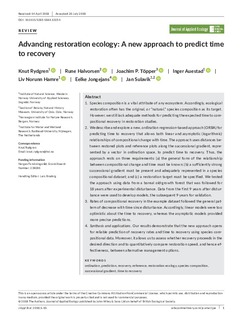| dc.description.abstract | 1. Species composition is a vital attribute of any ecosystem. Accordingly, ecological restoration often has the original, or “natural,” species composition as its target. However, we still lack adequate methods for predicting the expected time to compositional recovery in restoration studies. 2. We describe and explore a new, ordination regression-based approach (ORBA) for predicting time to recovery that allows both linear and asymptotic (logarithmic) relationships of compositional change with time. The approach uses distances between restored plots and reference plots along the successional gradient, represented by a vector in ordination space, to predict time to recovery. Thus, the approach rests on three requirements: (a) the general form of the relationship between compositional change and time must be known; (b) a sufficiently strong successional gradient must be present and adequately represented in a species compositional dataset; and (c) a restoration target must be specified. We tested the approach using data from a boreal old-growth forest that was followed for 18 years after experimental disturbance. Data from the first 9 years after disturbance were used to develop models, the subsequent 9 years for validation. 3. Rates of compositional recovery in the example dataset followed the general pattern of decrease with time since disturbance. Accordingly, linear models were too optimistic about the time to recovery, whereas the asymptotic models provided more precise predictions. 4. Synthesis and applications. Our results demonstrate that the new approach opens for reliable prediction of recovery rates and time to recovery using species compositional data. Moreover, it allows us to assess whether recovery proceeds in the desired direction and to quantitatively compare restoration speed, and hence effectiveness, between alternative management options. ordination, prediction, recovery, reference, restoration ecology, species composition, successional gradient, time to recovery | nb_NO |

